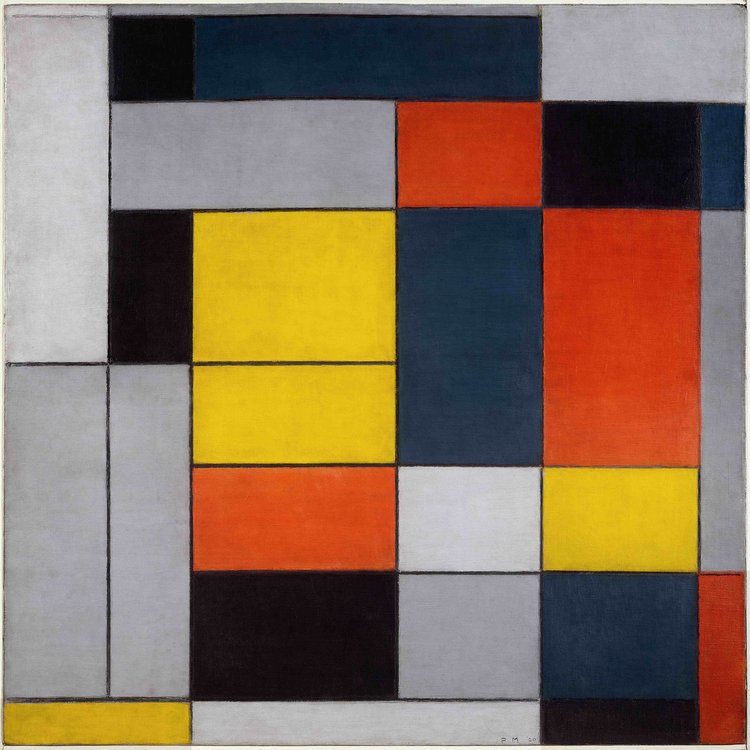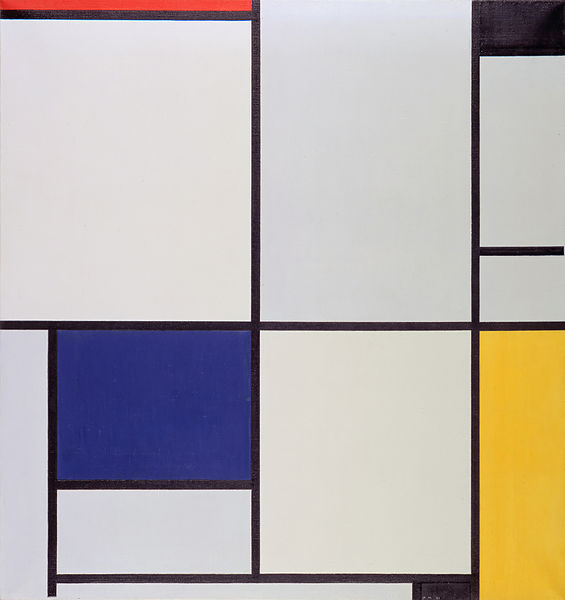Mondrian, Piet - VM - Nigel Halliday
Piet Mondrian: No. VI / Composition No. II

A Utopian Vision
by Nigel Halliday
Mondrian was a utopian idealist and, like many such, he was a mixture of barmy eccentricity and deep seriousness that generated great affection for him personally, as well as great works of enduring beauty.
Mondrian is known for his arrangements of black lines on white backgrounds, punctuated by squares and rectangles of primary colours, beautifully and intuitively balanced by eye. Yet stories of his eccentric behaviour abound. In his desire to imprint human rationality on nature, he is supposed to have gone for walks through the woods, making precise ninety-degree turns rather than follow the natural path. He is reported to have swapped seats in a New York cafe so that he could look at the buildings rather than the plants. He wore a shirt and tie under his painting overalls, looking like an undertaker, but danced to jazz in his studio as well as in nightclubs.
Mondrian’s painting is deeply serious. Like that other great pioneer of non-representational painting, Wassily Kandinsky, Mondrian was a theosophist. They believed that humanity was evolving not just physically but spiritually, and it was through the contemplation of art that the human soul would be enlightened and perfected.
Mondrian and Kandinsky were linked to and affected by the rationalism of 1920s architecture and design, which believed it could reform human nature through rational control of the environment. Mondrian’s paintings act like metaphors for a rationally balanced world: a huge red square can be balanced by a well-placed, but much smaller yellow and blue to achieve what he called ‘dynamic tension’. But over the years the idea of metaphor seemed to fade and he came to think of his paintings not as images of an unseen reality, but part of reality, part of the urban environment that he believed to be shaping human spiritual evolution.
In the 1920s he coined a term for his painting: neo-plasticism. It emphasises the plasticity, the physicality, of the work of art: the painting is not a traditional icon referring to a reality beyond, but a reality in itself. In the earlier images the edges are blurred, as if to show a separation between the image and the world of the viewer. But in the later work the lines continue to the edge of the canvas and there is no frame, suggesting the work continues into the surrounding area of wall. Indeed, at times in his writings you get the feeling that, if you peeled back the surface of the world with all its confusing multifariousness, there underneath you would see something akin to a Mondrian painting.

Utopianism implies that perfection can be reached and all other possibilities superseded. Hence his paintings work best when they are exhibited with each other and no one else’s. Rows of related but subtly varying Mondrians create a delightful environment that invites relaxed, serious contemplation. But when a Mondrian is put next to an expressionist, surrealist or war artist you are forcibly reminded of all the aspects of humanity that Mondrian is skating over.
In the end it is a vision that fails to take account of the true ills of human nature, just as its architectural counterpart failed to change human nature by changing his environment. But the vision itself is beautiful, as are the works.
*******
Piet Mondrian: No. VI / Composition No. II, 1920, oil paint on canvas, 99.7 x 100.3 cm. Tate, London, UK.
Piet Mondrian: Tableau I, 1921, oil on canvas, 103 x 100 cm. Kunstmuseum Den Haag, Netherlands.
Piet Mondrian (1872-1944) is a Dutch painter. During his career Mondrian developed from Impressionism through Symbolism and Cubism to his own form of abstract painting. He is seen as a pioneer of abstract art. Especially his later geometric-abstract artworks, with horizontal and vertical black lines and primary colours (red, blue, yellow), are well-known. They are a source of inspiration for many architects and designers.
Nigel Halliday is a freelance art historian, lecturer and teacher. He studied History of Art at Cambridge University and the Courtauld Institute, London. He teaches the whole canon of Western art from Giotto onwards, but his main interests have been nineteenth- and twentieth-century art. He has also researched and lectured on Michelangelo and Rembrandt, and particularly the influence of Protestant belief on their work. He writes articles and exhibition reviews for the Christian press, and leads retreats and study sessions around the themes of ‘Art and the Bible’, as well as other Biblical teaching. He is a Research Fellow of the Kirby Laing Institute for Public Theology in Cambridge.
This meditation is an adaptation of this exhibition review.
ArtWay Art Meditation January 8, 2023


